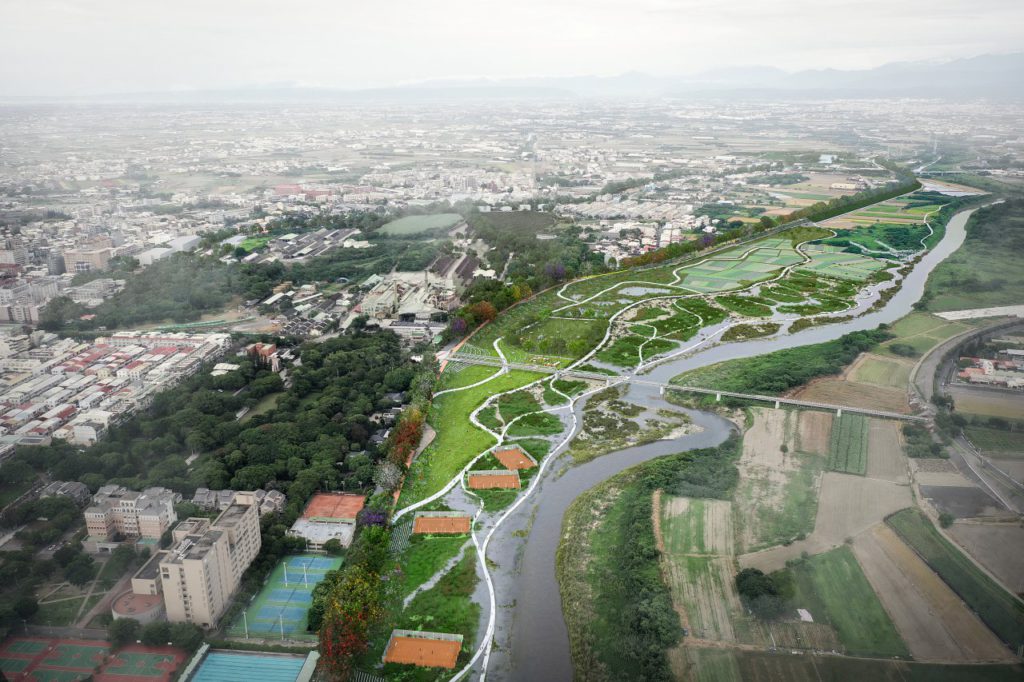Hoowave Water Factory by MVRDV: Modernising a town’s entire water network
January 17, 2024
Huwei is an inland town of around 70,000 people, located on the Beigang River. The area developed in the early 19th century around its sugar factory. While the sugar factory still operates, a connected alcohol factory was closed in the 1970s, becoming overgrown with tropical vegetation.

Today, the factory grounds, along with a dike built to protect the town from the river’s floods, form a significant barrier between Huwei and the Beigang River. The town suffers from water pollution resulting from its urban and agricultural growth, and is unprepared for floods and droughts that will come as a result of climate change.
A design competition held by the Taiwan Ministry of Economic Affairs called for a large-scale redevelopment of the Beigang River and Anqingzhen waterways. The proposal called Hoowave Water Factory was selected as the winning design, with completion expected as early as 2026.


A multipronged approach
The proposal focuses on five goals: Huwei’s new water system will be resilient, ecological, connected, cultural and feasible, especially considering the tight timeframe.
Combining both a strategic master plan and a landscape design, the proposal aims to modernise the town’s waterway network, ditching the ‘monofunctional’ approach to control and direct water. Instead, the town will have a system that captures and stores water for use and gives space to Nature and to urban life. A series of localised, naturally cleaned water buffers are proposed to be added throughout the city, with the majority placed on larger, publicly owned properties such as schools to streamline their implementation.


The design also aims to purify and naturalise the Anqingzhen Channel, an irrigation canal running through (and in places, beneath) the town that has come to serve as a polluted and smelly wastewater drain. The cleaned and naturalised canal will provide the opportunity to open the disused portions of the factory and create a park space in the heart of the town. By doing so, the Anqingzhen Channel can return to its former status as an important focus for leisure activities.
These master planning strategies allow the town to have a comprehensive strategy for flood resilience while improving the quantity and quality of the town’s available water, as well as integrating mobility networks such as cycle paths, cultural amenities and ecological systems.
Fostering waterside activities
By transforming the dike to the south of the town’s core into an accessible urban space, the design opens up the area between the river and the dike for further uses such as viewing platforms and sports fields. This area, called Beigang River Park, is split into multiple sections that take into account the expected frequency of floods at various distances from the river.
Three new cycle routes are added with the dike as their spine: one 2.7-kilometre loop around the boundary of the sugar factory; one 6.4-kilometre loop along the dike and back along the riverbank; and one 8.4-kilometre loop that connects the heart of the town to the Pinghe Flood Detention Pond in the east.


The proposed Anqingzhen Waterland shows how the naturalised channel can become part of a forested park in the disused zones of the sugar factory premises. As part of the city-wide flood control system designed to retain, purify, and reuse rainwater for leisure and biodiversity, the water levels of the Anqingzhen Channel here will vary according to the seasons, creating small islands for a number of leisure activities.
Meanwhile, the Pinghe Lake design proposes that what is currently a flood detention pond can become an ecology hotspot, and a destination on the edge of the city for walkers and cyclists.


PROJECT DATA
Project Name
Hoowave Water Factory
Location
Huwei, Taiwan
Status
Under construction
Expected Completion
2026
Site Area
50 hectares with 60 hectares of programmed spaces
Client/Owner
Taiwan Ministry of Economic Affairs (MOEA)
Architecture Firm
MVRDV
Principal Architect
Winy Maas (Founding Partner in charge)
Co-architects
The Urbanists Collaborative; Elite Engineering; jlin Architects
Water Consultant
Deltares
Electromechanical Engineering
Godson Engineering
Mobility Engineering
Smartway Solutions
Local Cultural Advisor
National Formosa University
Community Communication
Food Communication Taiwan
Visualisations
© MVRDV (Antonio Luca Coco; Jaroslaw Jeda; Stefania Trozzi; Marco Fabri; Lorenzo D’Alessandro)
Read more stories from FuturArc 4Q 2023: Water!

Don’t miss out on our ongoing competition—submit your entries for FuturArc Prize 2024: Architecture for Life After … now!

To read the complete article, get your hardcopy at our online shop/newsstands/major bookstores; subscribe to FuturArc or download the FuturArc App to read the issues.


